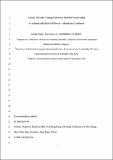Future climate change enhances rainfall seasonality in a regional model of western Maritime Continent
Author(s)
Kang, Suchul; Im, Eun Soon; Eltahir, Elfatih A. B.
Download382_2018_4164_ReferencePDF.pdf (3.527Mb)
Open Access Policy
Open Access Policy
Creative Commons Attribution-Noncommercial-Share Alike
Terms of use
Metadata
Show full item recordAbstract
In this study, future changes in rainfall due to global climate change are investigated over the western Maritime Continent based on dynamically downscaled climate projections using the MIT Regional Climate Model (MRCM) with 12 km horizontal resolution. A total of nine 30-year regional climate projections driven by multi-GCMs projections (CCSM4, MPI-ESM-MR and ACCESS1.0) under multi-scenarios of greenhouse gases emissions (Historical: 1976–2005, RCP4.5 and RCP8.5: 2071–2100) from phase 5 of the Coupled Model Inter-comparison Project (CMIP5) are analyzed. Focusing on dynamically downscaled rainfall fields, the associated systematic biases originating from GCM and MRCM are removed based on observations using Parametric Quantile Mapping method in order to enhance the reliability of future projections. The MRCM simulations with bias correction capture the spatial patterns of seasonal rainfall as well as the frequency distribution of daily rainfall. Based on projected rainfall changes under both RCP4.5 and RCP8.5 scenarios, the ensemble of MRCM simulations project a significant decrease in rainfall over the western Maritime Continent during the inter-monsoon periods while the change in rainfall is not relevant during wet season. The main mechanism behind the simulated decrease in rainfall is rooted in asymmetries of the projected changes in seasonal dynamics of the meridional circulation along different latitudes. The sinking motion, which is marginally positioned in the reference simulation, is enhanced and expanded under global climate change, particularly in RCP8.5 scenario during boreal fall season. The projected enhancement of rainfall seasonality over the western Maritime Continent suggests increased risk of water stress for natural ecosystems as well as man-made water resources reservoirs.
Date issued
2018-03Department
Massachusetts Institute of Technology. Department of Civil and Environmental Engineering; Singapore-MIT Alliance in Research and Technology (SMART); Parsons Laboratory for Environmental Science and Engineering (Massachusetts Institute of Technology)Journal
Climate Dynamics
Publisher
Springer Science and Business Media LLC
Citation
Kang, Suchul et al. "Future climate change enhances rainfall seasonality in a regional model of western Maritime Continent." Climate Dynamics 52, 1-2 (March 2018): 747–764 © 2018 Springer-Verlag GmbH Germany, part of Springer Nature
Version: Author's final manuscript
ISSN
0930-7575
1432-0894